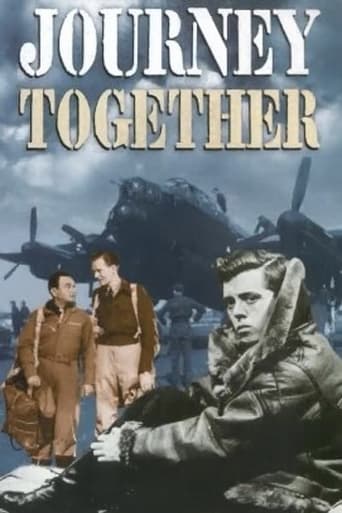

Truly Dreadful Film
... View MoreIt's a mild crowd pleaser for people who are exhausted by blockbusters.
... View MoreExactly the movie you think it is, but not the movie you want it to be.
... View MoreThere are moments that feel comical, some horrific, and some downright inspiring but the tonal shifts hardly matter as the end results come to a film that's perfect for this time.
... View MoreAs a Rattigan completist I have long coveted this film and now at last I own it on DVD. Whilst it would be ludicrous to compare it to The Way To The Stars, released the same year,for which Rattigan cannibalized his stage hit Flare Path, it's still a decent effort and worthy of being included in a time capsule of the period, The Way We Live Now and all that. Eddie Robinson gets co-star billing but has two reels screen time at most during which he manages effortlessly to outclass Dickie Attenborough who was still trying too hard to get noticed. Jack Watling takes what amounts to the second lead with David Tomlinson making up the numbers and a young George Cole in a blink-and-you'll-miss-him scene. Rattigan has cobbled a very workmanlike screenplay from this men only cast - albeit Attenborough contrives to slip a photograph of Sheila Sim under the wire. Now very much a period piece but a must for Rattigan buffs.
... View MoreJourney Together is a film made with a lot of the acting talent that was still in the Royal Air Force in 1945. In that respect it was like the David Niven film The Way Ahead which was done while Niven and the rest of the male members of that cast were still in the service. In this case Richard Attenborough who had made a big impression in a small role in In Which We Serve got to star in this film about a young enlistee in the RAF who wants to be a pilot.From the days of Eddie Rickenbacker to the days of Tom Cruise in Top Gun the glamor spot in the Air service of any country is being a pilot. You get the commission, the rank, and the best of the female groupies around. Attenborough's no different, but he does not make it as a pilot.However while training in Arizona he gets to work with instructor Edward G. Robinson who washes him out as a pilot, but says he can make it as a navigator. As Robinson puts it the pilot is just glamorized driver, he was the whole show in those single engine biplanes from World War I, but in this war he's just the head of crew and they all have jobs to do. Particularly the navigator and Robinson and I agree it takes brains to be a navigator, to read those charts and instruments and plot a right course. He fails, everybody fails.Attenborough gets a chance in combat to show how important navigators are and what he does is what you see Journey Together for.The presence of Edward G. Robinson albeit in a small role insured a few more dollars for the American market. But the film is Attenborough's and he does a fine job in the lead. Journey Together is a nicely plotted war film and aviation buffs will love seeing those vintage British airplanes.
... View More"That same day [30th August 1944], the RAF Film Unit arrived at Methwold with all of the necessary equipment to shoot the Squadron Lancasters for sequences in a movie titled 'Journey Together'. Great pains were taken to exclude No. 149's Stirlings from any of the shots." From "Strong By Night" History and Memories of No. 149 (East India) Squadron Royal Air Force 1918/19 - 1937/56; John Johnston and Nick Carter; An AIR-Britain Publication.In one of the external scenes of a Lancaster Squadron Station, there is a fleeting glimpse of a Lancaster in the background sporting the Squadron code letters "OJ" of 149 Squadron. The Squadron had just completed conversion from Stirlings to Lancasters and most of the Stirlings were still at Methwold, hence the comment about excluding them from any of the shots although whether that was at the RAF's or director's insistence is not explained.
... View MoreI was fortunate to be one of the students at one of the BFTS training schools in Texas. The main theme, was to show students that flunked the flying course that it was just as important to be retrained as a navigator or other crew member. The principal flight instructor was Edward G Robinson who is not listed. He gave his services free out of respect for the war effort. The "few" refer to the original fighter pilots that that served at the beginning of the war '39 to '42W.H.Stannard Ex RAF.
... View More